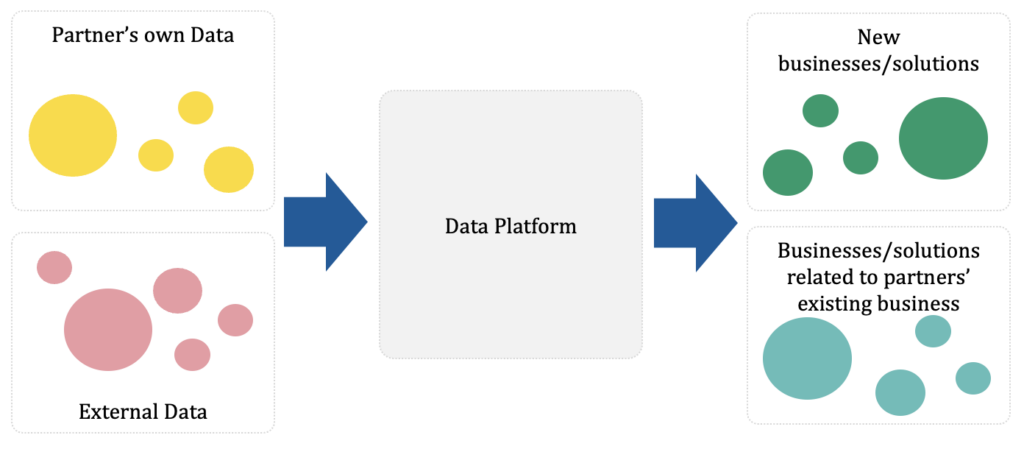The game is on. For example of the discussion about the opportunities related to generative AI are forcing organisations to rethink their ways of working. But that’s not all, there are a lot more opportunities related to data. It is essential part of digitalising business models that often call for collaboration. However, often when solving systemic problems any one organisation does not have access to data needed to solve those problems: Circular economy, energy transition, healthcare, autonomous vehicles or logistics – all of these topics call firstly collaboration between players and secondly data sharing.
So what’s new? Listening to SITRA’s Data Driven Competitiveness situation update it feels that we generally agee on the importance of data, and recognise the importance of data sharing. Yet, many organisations find collaboration challenging when it comes to data sharing. Why is that? And more importantly what can we do about it? Based on the vivid discussion, it seems to depend on the motivation or in other words purpose of collaboration.
Purpose: Clear view of the desired outcome
While data sharing is a good tool for solving systemic problems, there is no value of having data without understanding the context. Therefore, we recommend by defining a problem that needs solving, and clear articulation of why that problem is worthy of solving. In the Ecosystem Handbook, we suggested, that purpose should be clearly articulated, rationally and emotionally engaging, short and sweet expression of the desired impact. When jointly agreed and clearly defined, purpose helps ensure commitment in partner organisations and people. Combined with well-defined objectives related to profit, people and planet, we indicated that purpose serves as the foundation of fruitful collaboration to solve the articulated problem.
As collaboration typically involves a number of partners with very different objectives, cultures, and data, the first collaboration challenge to overcome is about defining purpose and objectives. Furthermore, when collaboration involves data, the fundamental discussions serve as basis in understanding what kind of data the partners have, how it can be shared and enriched to enable joint value creation. When the purpose is clear, the value creation can start. And that’s where SITRA’s Data Ecosystem Handbook comes handy.
From Purpose Onwards: Transparent Value Creation and Value Capture
The data ecosystems’ journey from value creation to value capture starts by understanding the roles of different partners, the types of data that they have and the ways of working needed to ensure that every partner benefits from the collaboration. In the beginning of the journey it is virtually impossible to foresee the innovations that are potentially discovered along the way. However, is essential to understand the types of data used as raw material for joint development, innovation and value creation (input) and the ways value can be captured from data (output). These are illustrated in the following picture.

Partner’s own data includes data assets that the partners have in their own systems. That data can be further enriched by complementary data from external sources (external data). Furthermore, collaboration, co-creation and joint innovation typically calls for data platform providing access to data and enabling value creation according to the agreed principles of collaboration.
As far as the output is concerned, it can be two-fold: Collaboration can lead to jointly developed entirely new businesses or solutions. However, another alternative, which may provide faster time to market and benefit especially smaller partners are innovations creating new complementary businesses or solutions related to partners’ existing businesses. Seems obvious? Maybe, but based on our experience, in many ecosystems there is sometimes false assumption that the partners’ solution will be joint new business as it is based on shared data. However, it may well be that partners can jointly develop solutions that for example complement partners’ existing businesses and solutions. And it is ok – as long as the partners understand the value creation logic (business model) and do not have false assumptions about the value capture logic – and everyone that participates in co-creation and joint development captures fair share of the value.
Time to move from “Talking to Walking”
This blogpost was inspired by the launch of Sitra’s Data Ecosystem handbook. It provides a systematic set of tools for creating value from data with practical examples of data ecosystems such as Traficom’s Fintraffic, SiX (Sustainable Industry, Mobile Work Machines) and FAMN (Finnish Advanced Manufacturing Ecosystem).
Moving from inspiration to action often calls for some perspiration. Therefore, we recommend discussing with peers or industry experts. They can help shape purpose and objectives, and define roles, responsibilities and practical actions needed to move beyond “potential actions”. Hence, in addition to Sitra, we recommend getting in touch with for example Taival who are experts in shaping (data) ecosystems’ business models or with Ioxio who can help build fair and transparent data platforms. With the systemic problems at hand and unlimited opportunities to create and capture value by collaborating, sharing and enriching data, it is important to move from talking to walking, i.e. taking action to create and capture value from data!




